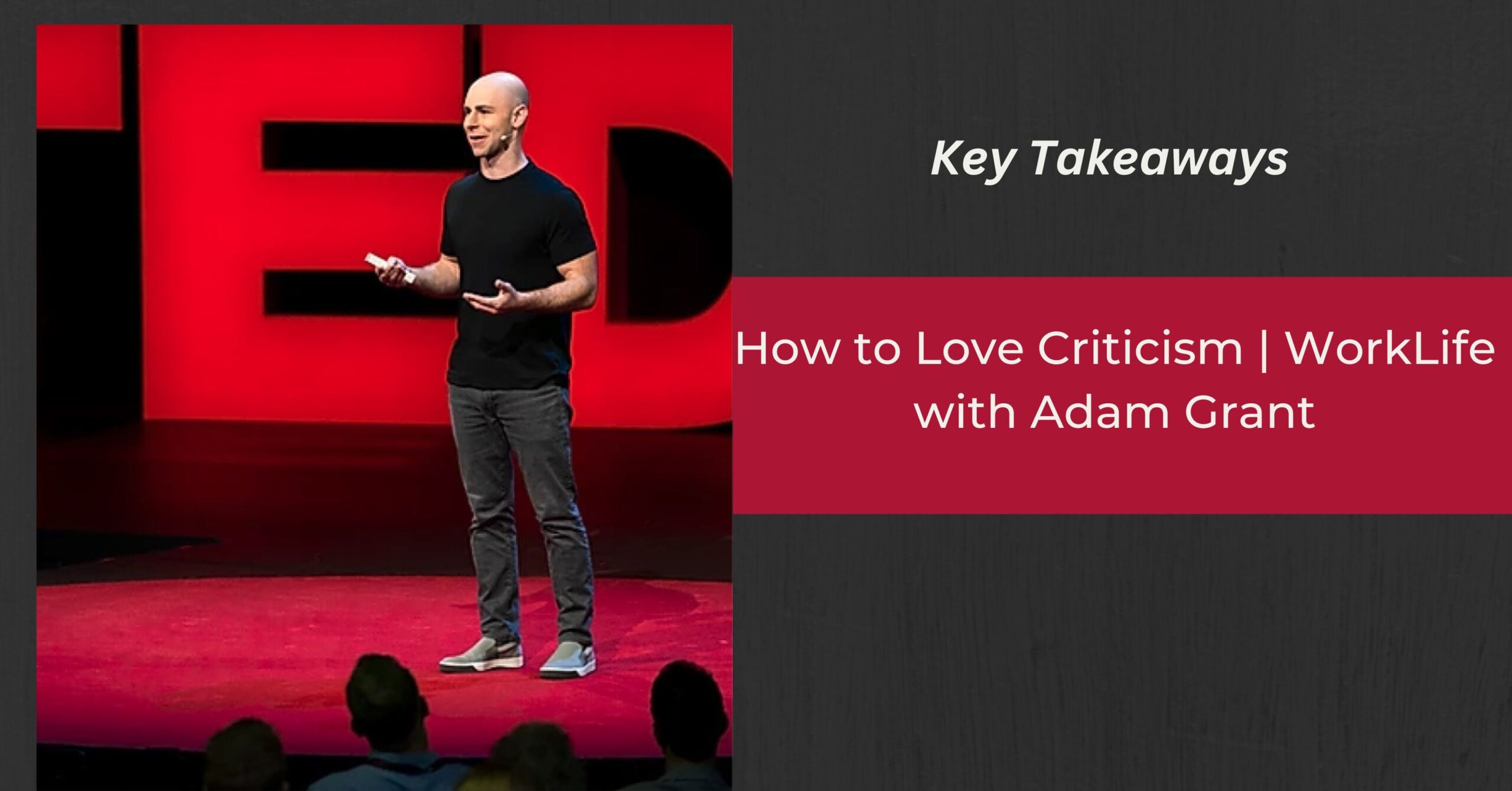How to Love Criticism-Key Learnings from Adam Grant’s TEDx Podcast
Adam Grant, a renowned organizational psychologist and author of the bestselling book “Give and Take,” has long been an advocate for the power of constructive criticism in the workplace. In his TED talk How to Love Criticism Grant explains that those who are able to accept and learn from criticism are more likely to be successful in their careers.
According to Grant, one of the keys to loving criticism is to view it as a growth opportunity rather than a personal attack. He suggests reframing negative feedback as “information about how to improve.” By approaching criticism with an open mind and a willingness to learn, individuals can turn a potentially negative experience into a positive one.
In his book Give and Take, Adam Grant writes,
Criticism is a powerful tool for improvement, but it’s also a double-edged sword. It can harm our self-esteem and relationships, or it can help us learn and grow.
So, how can we learn to love criticism? It’s important to remember that criticism can be difficult to hear, and it doesn’t always mean that the person giving it is right. So, it’s important to consider the source of the criticism and determine if it’s constructive or destructive.
Constructive criticism is meant to help you improve and grow, while destructive criticism is meant to tear you down. It’s important to be able to discern the difference and not let the latter affect you.
How to Approach Constructive Criticism (Feedback)
In the podcast, Grant quotes some examples that help us better understand how to receive feedback or criticism
Ray Dalio, the founder of Bridgewater Associates, is known for his unique management style and his emphasis on transparency and open communication. One of the ways he fosters this culture is by recording all meetings at Bridgewater and making them available to all employees.
In the 1980s and 1990s, when the company first started recording meetings, this practice was considered unusual, but it has since become a key element of Bridgewater’s culture. The recordings are used as a tool for learning and improvement, with employees encouraged to listen to them and provide feedback.
In one meeting, a person reporting to Ray received criticism that he was doing a poor job and would receive a D- grade for the meeting he held. Instead of keeping it to himself, he shared the feedback with the whole company. This is an example of how Bridgewater’s culture encourages transparency and open communication, even when it comes to criticism.
Another example is a manager at Bridgewater who received feedback that he was the worst manager in the company. Instead of feeling demotivated, he felt great about it and shared it with his wife. He used the feedback to improve and become a better manager.
According to Ray Dalio, the key to improvement is to learn from the extreme, and to build a “challenge network” of people who will critique you and help you improve. He also emphasizes the importance of not having a knee-jerk reaction to criticism and instead, to crave for criticism or negative feedback, as it leads to positive outcomes.
In a nutshell, Ray Dalio’s approach to criticism and feedback is unique and unconventional, but it has proven to be an effective tool for improvement and growth for Bridgewater Associates. The culture of transparency and open communication, along with the willingness to seek and give criticism, is one of the reasons for the company’s success.
Now, here are some of the key factors that will help you approach criticism in a better way:
1. Build A Growth Mindset
Separate the criticism from the person. Remember that criticism is not a personal attack. One way to take this is to adopt a growth mindset. Grant encourages us to focus on the problem, not the person, and to ask questions to gain more information.
It’s simply feedback on your actions or behavior. People with a growth mindset believe that their abilities can be developed through effort and learning. They see criticism as an opportunity to learn and grow, rather than as a personal attack. On the other hand, people with a fixed mindset believe that their abilities are set in stone and see criticism as a threat to their self-worth.
2. Ask for Feedback Rather Than Waiting for It
Another important aspect of learning to love criticism is to actively seek it out. Adam Grant suggests that we should “ask for feedback, even when it’s uncomfortable.” By actively seeking out criticism, we signal to others that we value their input and are open to learning and growing. Additionally, this proactive approach helps us identify areas where we need to improve, rather than being blindsided by criticism when it comes.
3. Consider It as a Learning Process
Another key to handling criticism well is to practice self-compassion. Instead of beating yourself up over criticism, remind yourself that everyone makes mistakes and that it’s part of the learning process. Additionally, try to separate your self-worth from your performance. Just because you received criticism doesn’t mean that you are a bad person, it simply means that there is room for improvement.
Finally, it’s important to remember that not all criticism is equal. While some criticism may be well-intentioned and helpful, other criticism may be malicious or misguided. It’s important to be able to filter out the useful feedback from the unhelpful criticism.
4. Learn to Give Constructive Feedback
Grant also emphasizes the importance of giving as well as receiving criticism. By offering constructive feedback to others, individuals can create a culture of growth and improvement in their workplace.
Furthermore, Adam Grant suggests that in order to give constructive criticism effectively, it should be specific, actionable, and kind. This means that criticism should be targeted at a specific behavior or action, should provide clear suggestions for improvement, and should be delivered in a way that is respectful and non-threatening. By giving feedback in a respectful and professional manner, we can set an example for others and make it easier for us to accept feedback when it’s given to us.
5. Listen, Reflect & Take Action
When receiving criticism, actively listen to the person giving it. Avoid interrupting or getting defensive. Take time to reflect on the criticism and consider how you can use it to improve. Once you have reflected on the criticism, take action by making a plan to improve.
Adam Grant suggests that when giving criticism, we should focus on the behavior, not the person. This means that we should avoid making personal attacks and instead focus on the specific actions or behaviors that need to be improved. Additionally, it’s important to provide specific examples and solutions, rather than just pointing out the problem.
Criticism can be tough to take, but it is an essential part of personal and professional growth. Learning to love criticism is a necessary skill for success in the workplace. By viewing criticism as a growth opportunity, seeking it out, and giving it in a respectful manner, individuals can turn potentially negative experiences into positive ones. By accepting and learning from criticism, we can improve ourselves and the organizations we work for.
As Adam Grant says,
The most successful people are the ones who can take criticism and turn it into improvement.




Leave a Reply